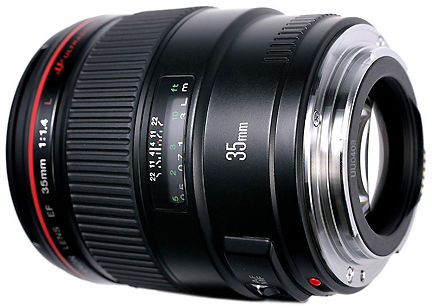1. The Canon EF 35mm f/1.4L USM is one of the classic lenses in the Canon line-up. Originally introduced during 1998, it is still revered by many professionals and serious amateurs for full-body portraits, weddings, wide-focal-length landscape photography, low available-light photography and any situation where a shallow depth of field is needed.
2. As soon as you hold this lens in your hand, you understand why it’s a member of Canon’s L, or Luxury, group of lenses, primarily for professionals. Photographers still marvel at the craftsmanship and the combination of solid metal parts and high quality plastic components. The rubberized focus ring is wide and easy to turn, plus you can use a polarizing filter on the front element because it does not rotate.
3. Given its substantial feel in your hands, the Canon EF 35mm f/1.4L lens is surprisingly small—3.1" x 3.4" (79mm x 86mm)(DxL)—and light—1.3 lbs. (580g).

4. Operating this lens, once it is mounted to your camera, is all any photographer could ever wish. With its Ring USM (Ultrasonic Motor), the lens focuses quickly and any AF noise is almost impossible to hear. From the one-shot AF mode, you also have available full-time (FTM) focusing.
5. Optically, the Canon EF 35mm includes 11 (lead-free) glass elements in 9 groups, with one ground aspherical element to correct aberrations.
Other optical goodies are an 8-blade diaphragm, a 72mm filter size and a petal-type hood.
6. The closest focusing distance is one foot (0.3m), so objects can be magnified to a maximum of ~1:5.5.7. Various third-party tests have revealed very minor, but noticeable, barrel distortions (0.5%) in the Canon EF 35mm.
8. It’s not unusual to have vignetting at f/1.4, given the extreme optical characteristics of such a wide aperture; however, as you reduce the aperture to f/2, and then f/2.8, (more reasonable apertures), vignetting is no longer an issue.
9. Resolution tests on the EF 35mm f/1.4 score excellent to very good, the best being the center resolution, even at f/1.4. The border resolution is down a notch to very good at the widest aperture, but quickly advances to excellent at medium apertures.
10. Chromatic aberration results were only average, which is surprising for a lens that is very good to excellent in overall ratings. These tests also recorded purple fringing at ultra large apertures.
11. Another third-party test for sharpness generated comparative results for the Canon EF 35mm f/1.4. Its center sharpness was not quite as good as the much less expensive Canon EF 35mm f/2.0 lens, but beat this lens in the corners. The EF 35mm f/1.4 also topped the f/2.0 version in contrast and saturation.
When compared to a Canon 24–70mm f/2.8L USM lens, set at 35mm, the EF 35mm f/1.4 registered about the same in terms of center and corner sharpness.
The closest Canon family member to the EF 35mm f/1.4 is the 24mm f/1.4L USM lens. Both share almost the exact same results in resolution and other tests.
When reviewing comparison tests data, the EF 35mm f/1.4 was noticeably sharper than the Canon 16–35mm f/2.8L with it set at 35mm and both lenses at identical apertures. The sharpness of the 16–35mm f/2.8 continued to improve, relative to the EF 35mm f/1.4, as the aperture narrowed to f/8 and beyond.
12. The Canon EF 35mm f/1.4L USM lens comes with an EW-78C lens hood and an LP1214 lens pouch.
13. At approximately $1,480, the Canon EF 35mm f/1.4L carries a hefty price tag, but it has the construction integrity and optical guts to make it worth every penny. That’s why Canon designed and built it for professionals.
Your feedback is important to thousands of PhotographyTalk.com fans and us. If this article is helpful, then please click the Like and Re-Tweet buttons at the top left of this article.
This blog about "Canon EF 35mm f/1.4L USM Lens" was first published on our website here https://www.photographytalk.com/photography-equipment-reviews/1746-13-powerful-points-for-the-professional-quality-of-the-canon-ef-35mm-f14l-usm-lens